M. Isidora Forrest's Blog, page 3
July 20, 2025
Hymns to Isis at Her Faiyum Temple
 Medinet Madi
Medinet MadiThe Egyptian Faiyum is in middle Egypt. In ancient times, it was an important oasis with its large, freshwater lake, fed by the Nile, and known in Greek as Moeris (from Egyptian Mer Wer, “Great Canal”). Humans have been in the area since pre-Neolithic times and a settlement, called Shedet, was established by the Old Kingdom.
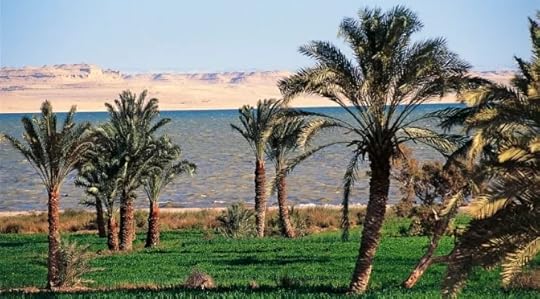 Lake Qarun
Lake QarunThe modern city of Faiyum is about 60 miles southwest of Cairo. The lake, now called Lake Qarun, is still there, but it’s much smaller, landlocked, and hyper-salty.
Anciently, the Faiyum was one of the main cult centers of the Crocodile God Sobek, where He was known as Sobek Shedety, “Sobek, He of Shedet.” Crocodiles, you see, were particularly plentiful in Lake Moeris. It is here in the Faiyum that Isis and Sobek meet up, especially in the temple complex at Medinet Madi (Gk., Narmouthis), at the southwestern entrance to the Faiyum. You can read more about Isis and Sobek here.
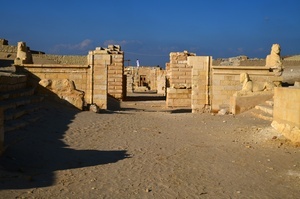 Courtyard at Medinet Madi
Courtyard at Medinet MadiThe Medinet Madi temple was originally built in the 12th dynasty and is the only surviving Middle Kingdom temple found to date. It was first dedicated to Sobek, to the cobra-formed Harvest Goddess Renenutet, and to Horus of Shedet. In the Greco-Roman period, the temple was dedicated to Isis as well.
Isis and Renenutet had long been syncretized, perhaps before the 5th century BCE. You will see the name of the combined Goddess as Isis-Thermouthis, Isis–Hermouthis, or Isis–Ermouthis. There’s also a version that combines the two Goddesses’ names as Isermouthis. So here we have the Goddesses continuing the Egyptian religious understanding of being able to combine, flow into, and “come forth as” each other.
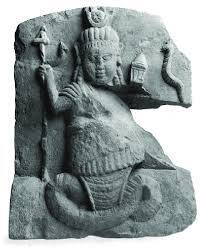 Isis Thermouthis from Medinet Madi
Isis Thermouthis from Medinet MadiCarved on the entrance pillars to the Medinet Madi temple’s forecourt, we find four hymns to Isis. If you read the hymns in order, their placement on the pillars leads the reader from outside the gate to inside the forecourt. In other words, the author of the hymns is leading his readers, through his knowledge of Isis, into Her temple.
Today, I’d like to tell you a little bit about those hymns.
They are the oldest of the famous Isis aretalogies (“speaking of virtues”) found throughout the Mediterranean world and were likely composed in the early part of the first century BCE. Unlike some of the other aretalogies/hymns, we know who composed them for he signed his name: Isidoros. Unfortunately, we don’t know much about Isidoros, other than he was a devotee of Isis and had enough wealth and prestige to have his compositions in Isis’ honor carved in Her temple grounds.
After his signature in the second of the hymns, Isidoros says that he has been given blessings of great happiness by the Deities, so the hymns as a whole may have been a thank offering. In his fourth hymn, Isidoros says that he investigated the history of the temple and “translated” his findings for the Greeks. This has made some scholars suggest that Isidoros may have been a bilingual Egyptian, maybe even a priest, who wanted to share his knowledge of his Goddess Isis with the Greeks. This was during the Ptolemaic period, when Greeks were ruling Egypt, and there were clearly enough Greek-speakers in Narmouthis that Isidoros wanted to write his hymns to the Goddess in Greek.
 Images of Isis-Thermouthis, now in the Louvre
Images of Isis-Thermouthis, now in the LouvreIsidoros’ hymns also demonstrate a blending of Greek and Egyptian religious traditions (the same type of blend we find in the Greco-Egyptian magical papyri, aka, the PGM.)
In these hymns, Isis is a universal Goddess and all powerful. She is benefactress to all human beings, the giver of all life, livelihood, and nourishment. She is the savior from all difficulties. Yet at the same time, She is also a local Goddess, using Her power for and giving Her favor to the people of the Faiyum as they celebrate Her local festivals.
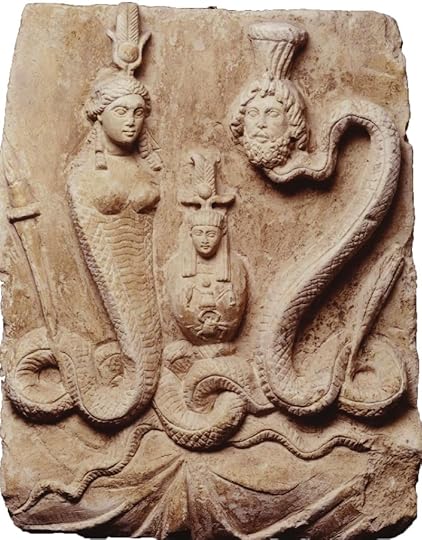 Isis and Sarapis as serpents; between Them is a canopic image of Osiris
Isis and Sarapis as serpents; between Them is a canopic image of OsirisWriting in Greek, and “translating” for Greeks, Isidorus uses a number of phrases also found in Greek epic poetry, as well as Greek poetic forms: hexameters (a rhythmic style) and elegiacs (metrical couplets). Earlier scholarship generally considered that the Greek Isiac hymns and aretalogies merely stuffed Isis into a Hellenized mold. But more recent study has shown that many of the phrases used in the hymns and aretalogies can be traced back to Egyptian originals, including specific Egyptian epithets of the Goddess. For instance, here’s a post on the aretalogy supposed to be from Memphis and the work scholars have done searching for the origins of its praises of the Goddess.
Interestingly, at least one scholar considers Isidorus’ hymns to be quite close to indigenous religious feeling—despite their Greek translations.
So that you can see the hymns for yourself and use or adapt them as you wish, I’ll reproduce two of Isidorus’ hymns, Hymn I and III. The English translations are from Vera Vanderlip’s The Four Greek Hymns of Isidorus & the Cult of Isis. You can download a copy of the whole book here. The work is a bit dated now, but still very valuable.
In Hymn I, we find Isis of the Many Names as a universal Goddess. Isidorus notes that the Egyptians call Her Thiouis, for they know that She, being One, is all Goddesses. Thiouis is a Hellenized version of the Egyptian epithet of Isis, Ta Uaet, “The Only One.”
Isis Hymn I from Medinet Madi temple
O wealth-giver, Queen of the Gods, Hermouthis, Lady,
Omnipotent Agathē Tychē, greatly renowned Isis
Dēo, highest Discoverer of all Life,
Manifold miracles were Your care that you might bring livelihood to mankind and morality to all.
You taught customs that justice might in some measure prevail;
You gave skills that men’s life might be comfortable,
And You discovered the blossoms that produce edible vegetation.
Because of You, heaven and the whole earth have their being; and the gusts of the winds and the sun with its sweet light.
By Your power the channels of Nile are filled, every one, at the harvest season and its most turbulent water is poured on the whole land that produce may be unfailing.
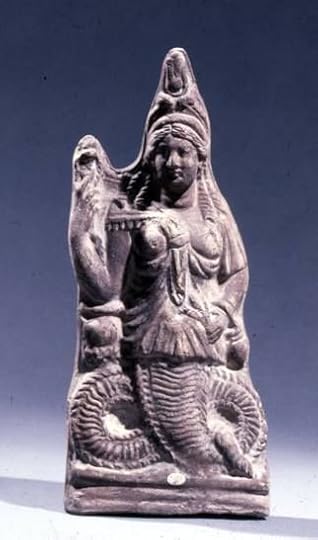 Isis Thermouthis, complete with Isis knot and fringed mantle
Isis Thermouthis, complete with Isis knot and fringed mantleAll mortals who live on the boundless earth, Thracians, Greeks and Barbarians, express Your fair Name, a Name greatly honoured among all, but each speaks in his own language, in his own land.
The Syrians call You Astarte, Artemis, Nanaia. The Lycian tribes call You Leto the Lady; the Thracians also name You as Mother of the Gods. And the Greeks call You Hera of the Great Throne, Aphrodite, Hestia the goodly, Rheia and Demeter.
But the Egyptians call You “Thiouis” because they know that You, being One, are all other Goddesses invoked by the races of men. Mighty One, I shall not cease to sing of Your great power.
Deathless Savior, many-named, mightiest Isis, saving from war, cities and all their citizens: men, their wives, possessions, and children.
As many as are bound fast in prison, in the power of death; as many as are in pain through long, anguished, sleepless nights; all who are wanderers in a foreign land; and as many as sail on the Great Sea in winter, when men may be destroyed and their ships wrecked and sunk, all these are saved if they pray that You be present to help.
Hear my prayers, O One whose Name has great Power; prove Yourself merciful to me and free me from all distress.
Isidoros wrote this.
Isis Hymn III from Medinet Madi temple
O ruler of the Highest Gods, Hermouthis, Lady, Isis, pure and sacred, mighty, of mighty name, Dēo,
O most hallowed bestower of good things; to all men who are righteous, you grant blessings: to possess wealth, a life that is pleasant, and most serene happiness: material gain, good fortune, and happy soundness of understanding.
All who live lives of greatest bliss, the best of men: sceptre-bearing kings and those who are rulers, if they depend on You, rule until old age, leaving shining and splendid wealth in abundance to their sons and sons’ sons, and to men who come after.
But the one whom the heavenly Queen has held most dear of princes, rules both Asia and Europe,
keeping the peace; the harvests grow heavy for him, with all kinds of good things, bearing fruit.
 Isermouthis; remember that Isis can take serpent form as a fire-spitting Eye of Re; the torch She has in this image is harmonious with that ancient understanding
Isermouthis; remember that Isis can take serpent form as a fire-spitting Eye of Re; the torch She has in this image is harmonious with that ancient understandingAnd where indeed there are wars and slaughter of countless throngs, Your strength and Godly power
annihilates the multitude; but to the few with him it gives courage.
Hear me, Agathētychē [“Good Fortune”: that is, Isis], when I pray to You, Lady…
Whether You have journeyed into Libya or to the south wind, or whether You are dwelling in the outermost regions of the north wind ever sweetly blowing,
Or whether You dwell in the blasts of the east wind, where are the risings of the sun,
Or whether You have gone to Olympus, where the Olympian Gods dwell,
Or whether You are in heaven above, a judge with the immortal Gods, or whether You have mounted the chariot of the swift-driving sun, You are directing the world of men, looking down on the manifold deeds of the wicked and gazing down on those of the just.
If You are also present here too, You witness mens‘ individual virtue, delighting in the sacrifices, libations, and offerings of the men who dwell in the nome of Suchos [Sobek], the Arsinoïtes [that is, those who live in the Faiyum], men of mixed races who all, yearly, are present on the twentieth of the month of Pachon and Thoth, bringing a tenth for You and for Anchoēs [Isis’ and Sobek’s son], and Sokonopis [Sobek], most sacred of Gods, at Your feast.
O Hearer of Prayers, Black-Robed Isis, the Merciful—and You Great Gods who share the temple with Her—send Paean to me, Healer of All Ills.
Isidoros wrote this.
For me, these ancient hymns and praises of Isis serve as rich pools of inspiration for my own work. I hope you enjoy reading them and may as serve as inspiration for your own heart-words to Isis.
July 13, 2025
Isis & the “Magical Mindset”

Ritual is how we DO religion.
And to do ritual, we perform a set of prescribed actions and, usually, words. Our rite may be something as simple as sitting quietly and counting our breaths or lighting a candle. Or it may be something as elaborate as an initiation ritual.
Yet just doing a set of actions and reciting specific words is not enough. Another vital component must be present in order to transform the actions and words from rote performance to real participation in the sacred. There must also be an psychospiritual component to our ritual. When the transformation from performance to participation is successful, we are taking part in sacred magic—a term particularly appropriate when it comes to Isis, She Who is Goddess of Magic par excellence. And because She is Lady of Magic—in Egyptian, Iset Nebet Hekau—I consider all Isiac ritual acts to be acts of sacred magic.
This is one of the reasons I was happy—thrilled, actually—to see the recent review of Offering to Isis by Foolish Fish. I was pleased because the reviewer had noticed that I included the ritual visualizations in the dromena, that is, the part of the rite that describes the ritual actions. Dromena might include things like purifying by sprinkling water, consecration with incense, walking a protective circle around your temple, or raising your arms in the Sign of the Wings of Isis—in addition to the breath-counting or candle-lighting already mentioned.

While the physical acts of ritual are important—and sometimes taking the action itself can help trigger the magical mindset when the dromena have been practiced extensively, it is the state of our minds, souls, and spirits—the “magical mindset,” if you will—that makes the ritual work. And by work, I mean that it connects us with the spiritual world, helps us communicate that which we wish to communicate, and helps us transform ourselves and/or our world.
What “mindset” conditions facilitate successful magic? Usually, these are a bit different for each person. Yet, I do think there are commonalities to look for.
For instance, if we can increase our sense of openness, both physically and spiritually, this will help us increase our magical perception. A feeling of expansion—in the heart, in the mind, in the spirit—all help us open ourselves to the Divine. We need to “uncramp” ourselves, loosening body, soul, and spirit. (That’s why we are so often advised to leave the cares of the outside world at the door of our ritual space.) What’s more, if we can cultivate in ourselves a feeling of expectancy and anticipation, we will be helping to create the right conditions for magic to happen.
 Jeszika Le Vye’s Isis; buy a copy here.
Jeszika Le Vye’s Isis; buy a copy here.We have the ability to attune our hearts and minds, allowing ourselves to enter into these expanded states. And when we do, the result is often a sense of connectedness. When we can take down our walls and remove our masks, we allow ourselves to become more aware of the connections that inevitably exist—connection with the natural world around us, with the symbols of the rite, with the other people who may be in ritual with us. Importantly, we can better perceive our connection with the unseen realms—and with Isis Herself.
This can be easier to describe than to achieve.
On the other hand, I know people—adepts of one tradition or another—who can tune into their magical mindset almost instantly. That’s because they’ve been practicing for many years. Most of us, most of the time, need to work at it in order to transform our everyday mindset into the magical mindset.
One way to do this is through visualization. Visualization is “seeing with the mind’s eye.” Visualization is creative imagination. And it is a powerful magical tool. In the Hermetica, the great Hermetic teacher Hermes Trismegistos (aka the Magician God Thoth) explains, “coming to be is nothing but imagination.” And you might recall that “coming into being” is one of the most common ways ancient Egyptian texts describe the creation of something new. “And so, X came into being,” texts say.
Many people are familiar with guided meditation, in which you try to imagine or “see” the scenes your guide is describing, yet you have your own reactions and experiences within the parameters of the guided visualization. But we can guide our own visualizations, too. I don’t mean just having our own free-wheeling reactions to whatever energy we’ve invoked, but actually guiding what happens and precisely imagining the energies invoked. This is not cheating; indeed, it is a key part of creating your magical mindset.
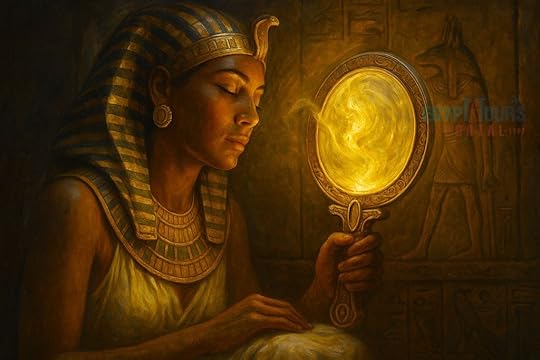
For some, visualization can be difficult. If that is the case for you, don’t be concerned. You may sense the unmanifest realms in other ways: hearing words, sensing things or simply “having a feeling.” Practice describing your perceptions to yourself in ways that make sense to you.
Nevertheless, many, even most, of us can teach ourselves to visualize. I’m probably dating myself here, but I taught myself to visualize using a book called the Silva Mind Control Method. While there are other aspects to the Silva method, to learn visualization, for 30 days in a row, you visualize an apple, each day adding more and more “reality” and sensual perceptions to the visualization. It worked for me.
But if you’re one who simply does not work that way, I’d suggest making your rituals symbol-rich. For instance, if you’re invoking the elements, have symbols of each element in the corresponding quarter of your altar—and know what the symbols mean; study them, read about them. Instead of visualizing, you can physically see and mentally contemplate the symbol, thinking about its meaning as you call-in each element. And don’t forget that words are symbols, too. The words of the ritual, as well as evocative poetry, can help transport us into the magical mindset.
For those who do visualize or would like to, I’ll share an example of how it can be used in ritual.
Let’s say we want to create those conditions of openness, expansion, and expectancy we talked about. This is precisely the purpose of the ritual of “The Opening of the Ways” in Isis Magic. It’s an all-purpose rite intended to create sacred space for communion with the Goddess, for meditation, for offering, or for any other act of sacred magic. In this ritual, we think of our own aura as a temple into which we are inviting the Presence of Isis. We visualize opening each of the directions (or “Ways”) to Isis, so that the energy and Presence of the Goddess can enter our temple.
Here’s what I often visualize:
In each direction (east, west, south, north, above, below, and heart-center) I imagine a pair of Egyptian pillars with translucent curtains closed between them. As I open each of the Ways, I will pull aside the curtains to reveal a scene beyond them.

For instance, as my physical body stands facing east with my arms before me, palms together, I prepare to Open the Ways to Isis of the East, the Lady of the Breath of Life, by making the Sign of the Opening of the Shrine.
In my mind, I see the two sculpted, Egyptian pillars, pale-yellow, sandstone colored. I sense that if I were to really look closely at them, I would see Egyptian hieroglyphs showing sails and fans and images of Deities of the Winds. But I need not always do that; for now, I simply see the pillars and the closed curtains before me. With my physical arms in front of me, I feel a bit of tension in my shoulders and arms and know that I will expend real energy when I open those curtains.
I say, “Let the Shrine of the East be opened unto Isis, only Isis,” and I open my arms out—wide—as I vibrate Her name: Iset Nef. I am sure to make this gesture fully in the physical so that I can take a deep breath and feel the openness in my own chest. At the same time, I imagine my hands pulling the curtains to the right and left so that I can now see out to the scene that lies between them.
I “see” that I am standing on a cliff where a cool, morning breeze blows softly as the sun rises in the dawning light. I breathe deeply, understanding that Isis of the Air is entering into my temple, into me, with each breath. I breathe the breath of Isis Herself, as She comes to me, comes to me. By now, I will usually feel something in my body, a tingle of energy, as the magical connection is made and I sense the Presence of Isis of the Air, the Lady of the Winds, the Queen of the Breath of Life.
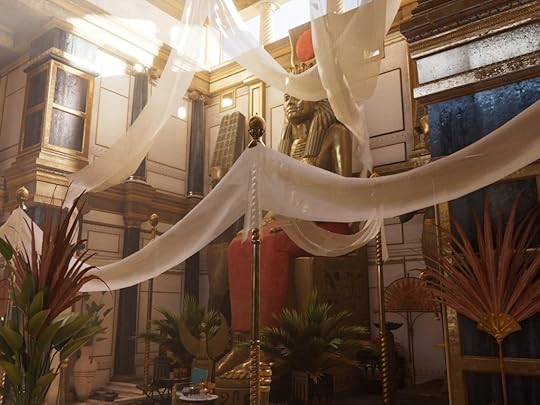
I repeat the same actions, but with different visualizations and Goddess names, at each of the Quarters, above me, below me, and at my heart. (If you want to try it, the ritual is at the link above.)
When I’ve completed these ritual actions and words, along with the visualizations, I should be well on my way to achieving my magical mindset. I will feel much more open, expanded, expectant, and connected, ready to commune with Isis or do any other work of sacred magic.
Even now, just describing it to you, I am almost, almost, almost there.
June 30, 2025
Capturing Sunlight—a Rite for Isis the Radiant One

In honor of the Summer Solstice-tide (locally, our festival was delayed until this weekend, so I’m still in solstice-mode), I bring you the rite of Capturing Sunlight, and a chant for Isis as The Radiant One, the Solar Goddess, the Golden One.
The Rite of Capturing Sunlight
Preparation for the Rite: For this rite, you’ll need a sunny day; time your rite for when the sun is high in the sky, also have some flash paper, a good-sized magnifying glass, a small brazier with very small kindling (such as wood shavings and twigs), a yellow pillar candle, and a vessel of water to douse the fire when you’re done.
Build a mound of the kindling and flash paper in the brazier so that when the flash paper ignites, it will catch the kindling on fire. Have the yellow candle ready to light from the brazier fire.
Opening
Stand fully outside in the sunlight and say,
Ritualist: What Exists LIVES when SHE shines!
Close your eyes and let the sunlight shine upon your eyelids. As the red-gold of Isis the Radiant One touches you, She sees you, recognizes you, knows you. And She coaxes you to growth in Her yellow heat. Like a lotus flower blooming, open yourself to Her, Isis the Radiant Goddess—to She Who is called the Gold and the Female Re and the Flame.
Raise your hands in the Gesture of Adoration and address the Goddess.
Ritualist: At this Summer Solstice-tide, at this hour, in the place, O Isis, Your solar fire is in its greatest strength. And so I ask a boon of the strong. I ask You to send a ray of Your soul-illuminating Light to guide me in the darkness of these times. Send Your red-gold sunlight, Goddess, and let Your magic be with me to light my way and illumine the shadows.
In Her name and by Her golden and fiery power, I invoke a ray of sunlight from the heart of the Goddess!

Invoking Her Light
Take out the magnifying glass and focus a beam of sunlight through the glass and onto the flash paper under the kindling. Chant until the flash paper ignites and the kindling catches fire.
Ritualist: (Chanting or singing softly)
Isis, I drink Your sunlight,
Radiant One, I breathe You in.
Isis, I eat Your magic,
Radiant One, take me within.
Once the kindling is burning, light the yellow candle from the fire and keep it protected from any breezes that might extinguish it.
Closing
Ritualist: I thank You Isis for Your Light—and always for your power, wisdom, magic, and love (add your own thanks as you wish). M’den, Iset, accept it, Isis.
Put out the brazier fire and clean up as needed. Take the lit candle to your altar for meditation; you may light it any time you wish to call upon Isis’ illuminating and fiery powers. You can blow the candle out and relight it with a standard firestarter without diminishing its magic.

June 15, 2025
Isis’ Philae Temple, pics!
I’m taking the day off today, so please enjoy these images of Isis’ temple at Philae from our Egyptian journey. It truly is the most beautiful of the surviving temples because of the stunning location.
 Taking the boat to Her holy island
Taking the boat to Her holy island
 Her temple from the boat
Her temple from the boat
 Circling around the temple to the dock
Circling around the temple to the dock
 First pylon
First pylon
 Exterior colonnade with Hathor headed pillars
Exterior colonnade with Hathor headed pillars
 The hypostyle hall
The hypostyle hall
 Isis protects Osiris
Isis protects Osiris
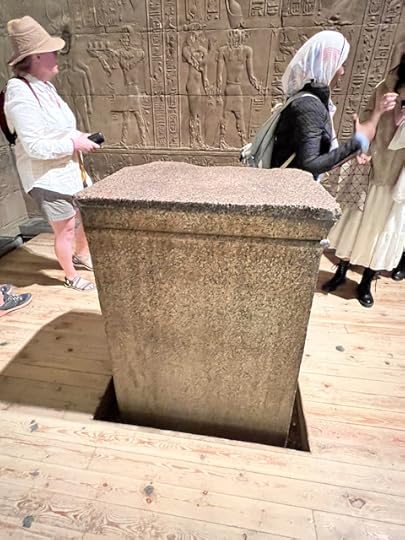 The main altar
The main altar
 View from the top of the temple facing south
View from the top of the temple facing south
 View from the top of the temple facing north
View from the top of the temple facing north
 Papyrus-form column detail
Papyrus-form column detail
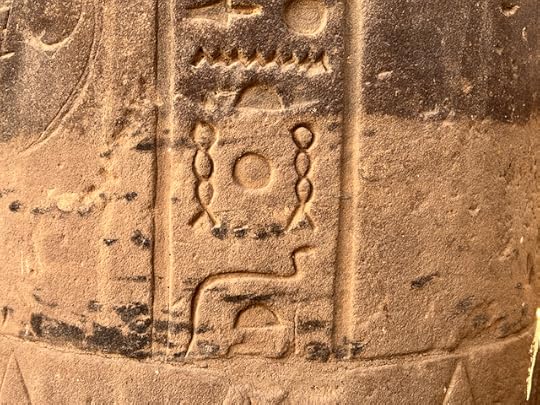 Hieroglyphs saying “Neheh and Djet;” learn more about that here
Hieroglyphs saying “Neheh and Djet;” learn more about that here
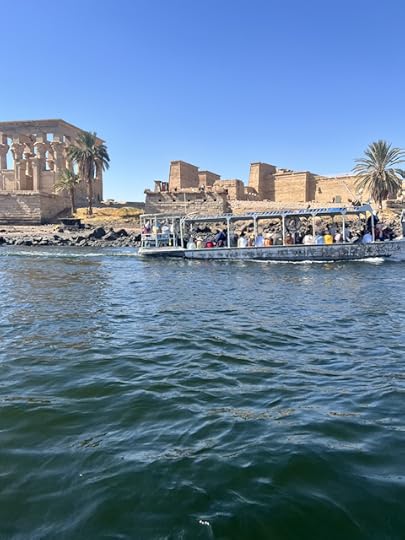 Leaving the temple around the other side; so we’ve made a full circle around the holy island
Leaving the temple around the other side; so we’ve made a full circle around the holy island
June 8, 2025
A Sacred Tree (and Fruit!) of Isis
Trees are sacred. And the more we know about them, the more we understand how very sacred they are.
The ancient Egyptians, of course, knew this, too. There were a number of trees they held sacred. Yet, perhaps the most intriguing was the ished. The ished is particularly intriguing because it remains a bit mysterious for it has not yet been identified with complete certainty.
 Mimusops laurifolia fruits and leaves
Mimusops laurifolia fruits and leavesAnd yes, of course, Isis is connected with this mysterious and sacred tree. She is, after all, one of the Egyptian Tree Goddesses.
The Ished in Myth
Mythically, the ished is one of the holy, solar trees associated with Re. It was the sacred tree at Heliopolis on top of which the bennu bird—the phoenix—was eternally reborn in fire. And it was the Tree of Life upon whose leaves and fruits Thoth and Seshat recorded the years of each king’s rule. The tree was also associated with the dead, with renewal, and with Isis’ beloved Osiris, “He Who is in the Heart of the Ished.”
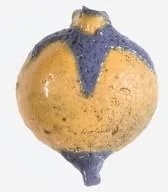 Ancient Egyptian bead in the shape of the mimusops fruit
Ancient Egyptian bead in the shape of the mimusops fruitBut What Tree is It?
Modern Egyptologists have variously identified the ished, with some of the confusion coming from the fact that the Egyptians themselves seem to have used the word for more than one tree.
 Mimusops flower
Mimusops flowerIn addition, there is some mythological overlap between the ished and another Egyptian sacred tree, the shwab. The most common identification of the ished/shwab today seems to be mimusops laurifolia, an evergreen hardwood tree with fragrant, white flowers and fleshy, eatable fruits. The wood can be used for carpentry and extracts from the bark can be used for tanning leather. It is native to the Ethiopian highlands and now rare in Egypt.
Others have identified the ished as balanites aegyptiaca, a spiny, semi-deciduous desert tree bearing smaller, oval fruits with purgative qualities. Fruits, leaves, and seeds of both trees have been found in Egyptian tombs; minusops leaves were also used in funerary wreaths.
 The Tree Goddess emerges from a persea and provides food and drink to the deceased
The Tree Goddess emerges from a persea and provides food and drink to the deceasedThe Persea & Isis
You will also see the sacred ished called by the Greek word persea. In fact, this is the most common name under which you’ll see the tree discussed.
The Greek priest Plutarch is a key source for connecting Isis with the persea. He tells us that the persea is especially sacred to Isis “because its fruit is like a heart and its leaf like a tongue.” He goes on to explain that this is because no human quality is more Divine than reason (especially when it concerns the Deities) and that there is no more driving human force than happiness.
So Plutarch is connecting Isis and the persea with two essentials of human life: relationship with the Divine via reason, and joy of the heart. Of course, this is Plutarch’s Hellenocentric interpretation. A more Egyptian interpretation might be that the heart-shaped fruit refers to the powers of the Goddess to bring forth “what Her heart conceived” while the tongue-like leaves represent “the magical power of Her mouth, being skilled of tongue.”
But we’re not quite out of the woods (so to speak) yet.
 Mimusops laurifolia
Mimusops laurifoliaAncient Greek and Latin writers applied the name persea to at least two Egyptian trees. According to the 4th-century-BCE Greek scholar Theophrastus, who made an extensive botanical study entitled Inquiry into Plants, in Egypt there is “another tree called the persea.” He tells us that this persea is large, attractive, and most resembles the pear tree “but it is evergreen, while the other is deciduous.” Theophrastus says that this persea is found only in Egypt.
Generally, Egyptologists today think the ancient authors were referring to the mimusops as the persea. Though, if Theophrastus is right and his record reflects Egyptian usage, the name persea was used for several trees. Which would explain the confusion about its identity.
Theophrastus’ description of the fruit of this evergreen persea is interesting, too. He says that the fruit is gathered unripe and stored. It is about pear-sized, but is “oblong, almond-shaped, and its color is grass green.” He describes the stone inside as like a plum, but smaller and softer. The flesh is sweet and luscious and easily digested and he mentions that it doesn’t cause problems even if eaten in quantity. (It is important to note that when the Greeks used the word “sweet,” they often meant “mild,” not sugary sweet.) Theophrastus’ description seems to better suit the mimusops, the fruit of which is described as delicious, rather than the smaller, purgative fruit of the balanites. Yet mimusops fruit is rounder rather than almond shaped, so perhaps the persea retains its mystery.
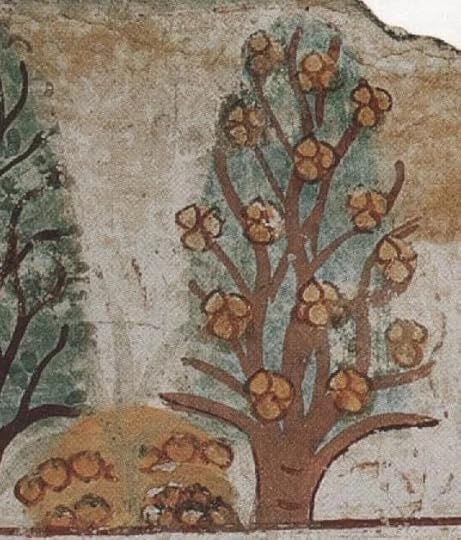 The persea from an ancient Egyptian painting
The persea from an ancient Egyptian paintingOsiris & the Persea
In addition to Isis’ connections with the heart-like fruit and tongue-like leaves of the persea, Osiris has His own persea associations. One of His key symbols, the djed pillar, is a stylized tree. The djed is sometimes shown with eyes and arms that hold the Osirian crook and flail, as if the God were alive within the pillar—causing some Egyptologists to suggest that He was originally a tree spirit.
You may recall that in Plutarch’s telling of the Isis myth, a tree magically grows up around the coffin of the murdered God and is later made into a pillar. In this way, Osiris is indeed within the tree and within the pillar. That tree, too, has been variously identified, from erica to tamerisk to cedar. But if Osiris is the Heart of the Ished, it seems reasonable to assume that the tree that grew up around the body of the Tree God was the holy ished or persea.
A Ptolemaic text records the dedication of an altar and a grove of persea trees to Osiris, Serapis, Isis, and Anubis. In the Roman period, a member of Isis’ Philae temple staff, recorded his good deed of planting four sacred shwab trees, one at Her temple, and three in or outside the nearby town.
We Can Still Honor Isis with Persea Today
 Persea americana fruits—avocados!
Persea americana fruits—avocados!While it is unlikely that we will be able to find either the fruit or the leaves of the ancient Egyptian persea today, there is a persea readily available to many of us.
It is the persea americana, our supermarket avocado. Originally from Central America and Mexico, the avocado is a member of the genus persea, evergreens of the laurel family. The persea americana was first so named by the English botanist Philip Miller in 1768. Theophrastus’ description of the Egyptian persea’s fruit no doubt influenced Miller’s choice because his description of the persea’s fruit fits the modern avocado rather precisely.
So, if you wish to honor Our Lady of the Tree—Who conceives in Her heart and speaks All Things into being with Her tongue—you might consider offering Her a lovely bowl of beautiful, green avocados.
June 1, 2025
Isis the Rebel
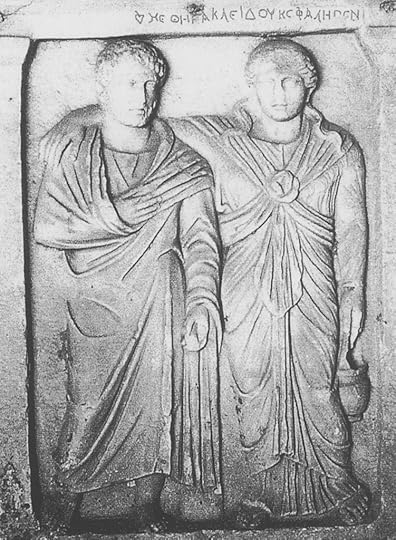 Athenian grave stele with the woman in Isiac dress; note her embrace of her (I presume) husband, which is reminiscent of many Egyptian couples’ funerary images.
Athenian grave stele with the woman in Isiac dress; note her embrace of her (I presume) husband, which is reminiscent of many Egyptian couples’ funerary images.Dear rebels and resisters, I want you to know that Our Lady is right there with us.
It seems to be part of Her nature.
Interestingly, quite a number of ancient Athenian Isiacs—living under Roman imperialism—chose to have themselves represented on their tomb steles in Isiac dress as a way to reclaim some of their own individuality.
An article I was reading about this suggested that these people wanted to represent themselves in other than the standard Greco-Roman manner because it let them preserve some of their self definition and personal power (as well as cultic status) in an era when they felt they had little of it politically. And, of course, these people were mostly, but not all, women—people who have had little political power at the best of times, in ancient society and now in far too many places.
In other words, these people were rebelling against Roman societal rule in a way that helped them fashion new and more complex selves—and Isis helped them do it.
Oh, but it started much earlier than that.
 The 1990 debut album of Lin Que, rapping under the name of Isis, was Rebel Soul.
The 1990 debut album of Lin Que, rapping under the name of Isis, was Rebel Soul.Although you still see Isis described as “the ideal wife and mother”—which often has connotations of 1950s housewife—I’ve always thought of Her as quite rebellious in that She always does exactly what She wants to do, and does not let anything stop Her.
That’s why I was taken aback when a friend once remarked to me that she couldn’t get into Isis because of the subservient way She went around “picking up after Osiris.” My friend was, of course, referring to the main Isis-Osiris myth in which Isis travels the length and breadth of Egypt to find and conduct proper funeral rites over the scattered pieces of Her murdered husband’s body.
 I love this
I love thisI, on the other hand, have always considered the ancient myth of Isis to be pretty darned feminist, modeling both feminine power and independence. Indeed, my own feminism is one of the reasons I began exploring Goddess in the first place.
My friend had seen the Isis-Osiris myth as just another “woman-taking-care-of-her-man” story, while I’d seen it as precisely the opposite: a tale of the reversal of stereotypes. Instead of the prince saving the princess, the princess had to save the prince, put him back together, and give him renewed life.
We were both right, of course. A myth speaks to us however it speaks to us. Nevertheless, I think that Isis and Her cycle of myths, especially when you include the important Isis & Re story, provide a proto-feminist model.
 The woman pharaoh Hatshepsut
The woman pharaoh HatshepsutPart of the credit for this goes to ancient Egyptian society. While we should have no illusions that men and women were true equals in Egypt, still they were more equal in Egypt than in any of Egypt’s Mediterranean neighbors. In Egypt, women could hold and sell property; they were considered (at least theoretically) equal to men before the law; they could instigate lawsuits; they could lend money; and although it was unusual, a woman could live independently, without a male guardian. In contrast, Greek and Roman laws firmly relegated women to control by their husbands or male relatives and provided little economic or legal protection to women.
So when Isis’ myths depict Her acting autonomously for Her own ends or wielding power, this type of female behavior was not as strange in Egypt as it was in the rest of the Mediterranean world. Another example of Isis wielding power are the tales of Isis as warrior that we have from the tales in the Jumilac papyrus.
Even when Egypt was ruled by non-natives under the Ptolemies (from 305 to 30 BCE), the native Egyptian respect for the feminine and The Feminine seems to have crept in. By the end of the dynasty, the historian Diodorus Siculus (Diodorus of Sicily) could write that due to the success of Isis’ benevolent rule of Egypt (while Osiris was on His mission to civilize the world):
…it was ordained that the queen should have greater power and honor than the king and that among private persons the wife should enjoy authority over her husband, the husbands agreeing in the marriage contract that they will be obedient in all things to their wives.
Diodorus Siculus, Book II, section 22
This wasn’t true, but it is interesting that it would be the impression that Diodorus received when visiting Egypt and speaking to Egyptians.
 The deceased lady, Djed-Khonsu-iw-es-Ankh, worships Re-Horakhty in the Otherworld
The deceased lady, Djed-Khonsu-iw-es-Ankh, worships Re-Horakhty in the OtherworldI’m also reading an article in the Journal of Hellenic Studies by Rachel Evelyn White about women in Ptolemaic Egypt that discusses the possibility that the family tomb may have been the property of a female heir, and which was likely a holdover from ancient Egyptian tradition. This is based on some Egyptian contracts of the time combined with the fact that this was specifically the case among the nearby Nabataeans. If so, this could be one of the bases for retained female power in Egypt, as well as giving women another connection with Isis as the provider of proper burial and funerary rites. It may also point to very ancient matrilineal (not matriarchal) traditions in Egypt.
We should also recall that in several of the remaining Isis aretalogies, the Goddess declares women’s equality with men. What’s more, the relationship between women and men is meant to be friendly and loving—like the relationship modeled by Isis and Osiris. The aretalogy from Maroneia states that Isis established language so that men and women, as well as all humankind, should live in mutual friendship.
In a later Hermetic text entitled Kore Kosmu, Isis explains to Horus the origin and equality of male and female souls, declaring that:
The souls, my son Horus, are all of one nature, inasmuch as they all come from one place, that place where the Maker fashioned them; and they are neither male nor female; for the difference of sex arises in bodies, and not in incorporeal beings.
Scott, Walter, Hermetica, Vol. 1 (Boulder, Colorado, Hermes House, 1982), p. 499-501.
The states it quite plainly: “Thou [Isis] didst make the power of women equal to that of men.” I know of no other ancient texts that lay out the message of equality so strongly as is done in the Isis aretalogies and hymns.
And so, I honor Our Lady, Isis the feminist, Isis the rebel and resister. May She help and support us in this difficult time.
May 25, 2025
More from the Temple of Isis at Dendera
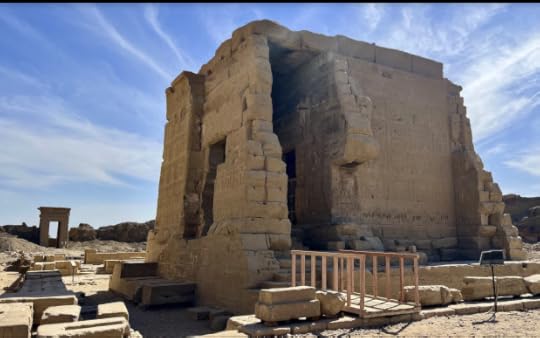 The temple of Isis at Dendera
The temple of Isis at DenderaAfter a few weeks, I’m finally getting back to Dendera and some of the texts inscribed on the walls of the small Isis temple there.
As you may recall, the temple is sometimes called the Birth House of Isis, which celebrates the birth of Isis from Her mother Nuet.
One of the temple walls says explicitly, “On this beautiful day, the day of the Child in His Nest, a great festival throughout the country, Isis is given birth at Dendera by Thoueris [“The Great One;” in this case, meaning Isis’ mother Nuet] in the House of the Noble One [the Noble One is Isis], a woman with black [kemet] hair and red [desheret] skin, full of life, Whose love is sweet.” Her mother Nuet says that She “makes every person rejoice to see You [Isis].”
With Her kemet hair and desheret skin, the Goddess encompasses the Black Land and the Red Land of Egypt. You may also recall from last time that this temple is very much concerned with the sovereignty of Isis over the entire land of Egypt.
 From an Isis manga by Tappytoon
From an Isis manga by TappytoonAnother temple inscription says, “Destiny distinguishes Her on the birthstones. He heart is rich in all virtue. The south is given to Her until [that is, “as far as”] the [place of the] rising of the Disk, the north until the limits of Darkness. She is mistress of the sanctuaries of Egypt with Her son and Her brother Osiris.” She is “Queen of Upper and Lower Egypt.” She is “Mistress of the cities and Sovereign of the Nomes, the Sovereign of Sanctuaries.”
As this is the temple of Isis’ birth, we have many Birth Goddesses present, including a form of Isis Herself. We find Meskhenet, the Birth Goddess Who sometimes takes the form of a personified birth brick, in four different forms. Meskhenet the Great in the Mound of Tefnut is Tefnut Herself. Meskhenet the Great in the Mound of Birth is Nuet. Meskhenet the Beautiful in the Place of Nativity is Isis. And Meskhenet the Excellent in the Temple of the Menat Necklace is Nephthys.
However, in a different part of the temple, the four Meskhenets are Djedet (Djedet is the principle Goddess of the town of Djedet, also known as Hatmehyt. Learn about Her connection with Isis here.), Nuet, Meskhenet the Beautiful in the Enclosure of Life, Who is Isis, and Meskhenet the Excellent in the Heart of the Land, Who is Nephthys; She is also called Efficient (Akh) for the Daughter of Geb (although Nephthys is Herself a Daughter of Geb, this likely means that Nephthys is akh for Isis).
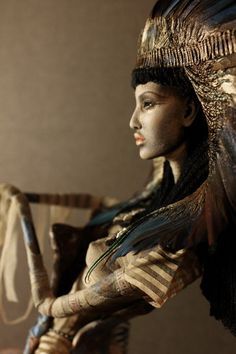 “Nephthys” by the Popovy sisters
“Nephthys” by the Popovy sistersAnd speaking of Nephthys, here are some more of Her epithets found in this Isis temple: She is The Excellent and The Efficient. She is the One Whose Breast is Shimmering. She is the One Whose Face is Beautiful, the Mistress of Adornments, and Mistress of Light in the Cavernous [Zones]. And both Sisters’ mother Nuet is called The Unknowable. Which I love so much. All my Goddesses are, ultimately, Unknowable.
This small temple is the source of one of the inspirations for what will be one of our ritual acts at SunFest, our local summer solstice festival in June. There is a section of a wall labeled “Spreading a dusting of gold and green earthenware on the ground at the Mound of Birth.” The Mound of Birth is the place where Isis is born. It is also the place where the entire world is born, when it first emerges from the primordial Waters. It is well to honor this sacred place within the temple. Indeed, all temples were considered to be the Primordial Mound where the world first emerged from the Waters.
What caught my eye in this case was the idea of scattering gold dust and powdered green faience in this holy place as a consecration. It reminds me of the colored powders scattered during the Indian Holi festival. During our Festival of the Return of the Wandering Goddess, we’ll be doing something similar and scattering dried flower petals in the path of the Returning Goddess to consecrate the Way of Her Return. If we happen to get some on each other in the process, oh well.
 Hathor as Cow Goddess
Hathor as Cow GoddessWhile Isis, in Her birth temple, is said to be the First One Born Among the Goddesses, nevertheless, Hathor as a Cow Goddess is there at the same time and licks the baby Goddess Isis on the day of Her birth—just as mother cows lick their calves at birth. (Of course, Nuet can also be a Cow Goddess; She is, in fact, the Cow Goddess referred to in the famous text known as The Heavenly Cow.)
At Isis’ birth Hathor sings, Khnum makes the “Divine body” of the Goddess, that is, Her sacred temple image. The ka and the hemsut (feminine fate spirits associated with the ka) rejoice as They receive Isis’ Mysterious Image, that is, Her temple statue. Nekhbet as the Uraeus vows to sit upon Her brow to protect Her. Other Goddesses also vow protection for Isis as Thoth promises that He will write Her stories.
One of the parts of the temple is called the Sanctuary of the Vase, which the king made for Isis “to protect Her body in his sanctuary in joy, to preserve Her Divine Images there.” Isis is said to enter “Her chapel in the Land of Atum, Her heart is glad to enter there.” The Sanctuary of the Vase then is the storage area for Isis’ sacred images and the Goddess is pleased with the images and so She happily enters into the image and Her sanctuary. The king has made the sanctuary for She Who is Full of Life and the images “are excellently chiseled by the work of the sculptors, enhanced with gold to perfection.”
 The main sacred image in my Isis shrine is a replica of this one
The main sacred image in my Isis shrine is a replica of this oneHere’s another thing I found interesting. One temple text says that the bas (manifestations/powers/a mode of Divine Being) of all the Deities follow the ba of Isis and They “melt” over Their effigies on the walls in joy.
I am very much intrigued by the idea of Isis’ ba—an aspect of Her Divine energy that indwells Her sacred image—melting over the image. Sometimes the Divine ba is said to swoop down from the heavens like a bird to alight on the sacred image. But melting over and into it—infusing the image with Her ba—really catches me.
I shall definitely use that visualization the next time I invoke Her to the sacred image that dwells in my home shrine for Her. And that is something else to note. We don’t just invoke Our Divine Ones to Their sacred images and call it done. Each time we invoke Her, She comes anew. Each time we ask Isis to come to us, come to us, She once again “melts” over Her sacred image.
That’s as far as I’ve gotten in my books for now. I’ll share more of what I learn as I go along.
May 18, 2025
SunFest 2025: The Return of the Wandering Goddess
June 27-29, 2025 Portland Oregon area
The ritualists for this festival are meeting today at my house for rehearsal. It’s getting REAL and I’m getting excited! If you’re in or near the Pacific Northwest, I hope you’ll join us for our upcoming summer solstice festival for 2025. SunFest 2025 is being put on by Other Worlds of Wonder (OWOW), please visit their website at the link below. I am serving as ritual facilitator—along with a truly wonderful Crewe of ritualists and craftspeople. It is going to be pure magic!
Read all about the festival rites and rituals here:
The Myth of the Wandering Goddess is one of the two most important myths of ancient Egypt. Just about every town or region had its own version of the festival that celebrated this myth. Although different Goddesses were the “Wandering Goddess” in each local area, our festival celebrates the power of Sakhmet and the ecstasy of Hathor.

During SunFest 2025, we’ll explore this important myth in an immersive, participatory way. Each ritual, presentation, or workshop is designed to draw us into the overall myth so that—together—we will live our own version of that myth and celebrate the festival that surrounded it.
SunFest 2025 takes place Friday through Sunday at Camp Cedar Ridge—as we await Ffynnon’s private park status.
Friday
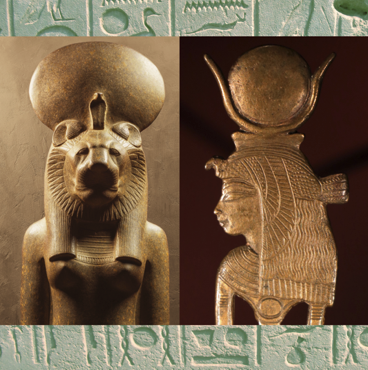
Creating Altars & Invoking Hathor & Sakhmet
Our first ritual act is to create altars for the Goddesses and to invoke Their presence to our festival. You’re invited to bring items to add to the altar. We will create it together as part of the rite. Then, with the altars prepared, we invoke our two festival Goddesses, the Fierce Goddesses of the Solar Eye: Hathor, the Golden One, and Sakhmet, the Powerful One.
Through our desire, through our invocations, through our music, and our moving bodies, we call upon our Goddesses to be present with us during this festival.
Sedj Desherut, the Ritual of Breaking Red Pots

The ancient Egyptian Ritual of Breaking Red Pots was performed to protect against enemies, physical and/or spiritual. Archeologists have found fragments of the pots that had been inscribed with curses against said enemies. In our version, we will join with Sakhmet in Her righteous anger against the injustice in the world and smash our own “red pots.” By expressing our rage, both personal and societal, we begin the Sacred Work of becoming purified and renewed.
At the end of this ritual, the Goddess Sakhmet departs from us and we are now without the powerful protection of our Goddess.
Seducing Sakhmet, Dancing for Her
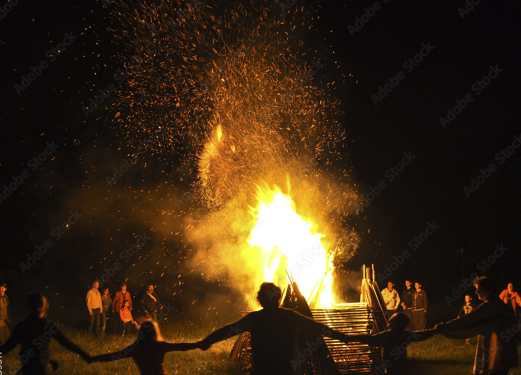
The Hathoru, sacred enticers of the Goddess Hathor, will help us get the Friday night drumming and dancing going with a calling for the absent Goddess and a chant to seduce Her to return.
Saturday
Workshop: The Myth of the Wandering Goddess
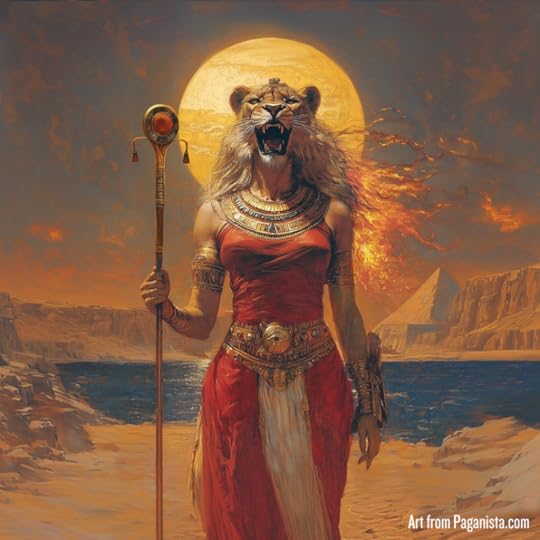
I’ll present a talk and slide show to explain the importance of this myth to ancient Egypt and provide background to help us understand the rituals and activities of the festival.
At the end of the presentation, we’ll have the opportunity to experience the energies of both Sakhmet and Hathor for ourselves.
Sehotep Sakhmet; Pouring Out Red Beer for Her
Five gallons of red beer are being ritually brewed as an offering to Sakhmet, so that we may appease Her wrath and coax Her to return to us. Without our Fierce Goddess, we, like the Sun God Re, are vulnerable. The First Servant of Sakhmet will lead us in a prayer and chant to the Goddess. Then we will pour out the blood-red beer into the fields in hopes that the Goddess will be pleased and made peaceful through it.

Workshop: Creating Offerings
We’ll break into 5 groups, our “villages.” Each village will work together to create an offering for the Returning Goddess—as She has been promised by Thoth, the God of Wisdom, if She agrees to return home.
The Return of the Wandering Goddess; Hathor is in Joy
Wise Thoth has followed the Lioness Goddess to Nubia and has entertained Her with many excellent stories. He has coaxed Her to return home, promising offerings, dancing, and feasting in Her honor.

Join us at the riverbank, our isheru, where the Returning Goddess is renewed in the Deep Primordial Waters. We, like our Goddess, will be purified and renewed as well. By our rites and in these Waters, Red Sakhmet transforms Herself into Turquoise Hathor, the Intoxicating One.
Then we walk together in procession as we make music and throw flower petals in the path of the Returning Goddess—and at each other, if we’re feeling playful. The Goddess’ reed boat stops at each village and we present our offerings to Her.

Community Picnic
We join together in the main meadow to feast with our Community and in honor of our Goddesses, Hathor and Sakhmet, and Thoth.
Blessings of the Seven Hathors
As the sun sets, we are called once more to gather at the Fire Circle. The Goddess will be present in 7 different forms and She will bless us in return for the offerings we created and presented to Her earlier.
There is no formal end to the ritual. We drum and dance our way into the night as we so desire.
Sunday

Pouring Out Pure Milk for Her
This is the closing ritual for the festival. We pour out pure milk in thanks to Sakhmet, Hathor, and Thoth, then ritually release Their Presences by extinguishing our fiery torches in the sacred milk of the Goddess.
The rite also incorporates OWOW’s traditional gift exchange. If you wish to participate, bring a small gift with you as a thanksgiving to be given to someone in our community, and you will receive one in return.

PLUS—Join us for a workshop on magic and protest later on Sunday!
How to Register
May 11, 2025
Isis Outside of Egypt
 A statue of Isis from a private sanctuary of the Egyptian Gods near Marathon, Greece built by a Roman statesman.
A statue of Isis from a private sanctuary of the Egyptian Gods near Marathon, Greece built by a Roman statesman.How many of us were Egyptophiles from very early on in our lives, even as children? That’s true of me. You, too?
The power of ancient Egypt is magnetic, irresistible. And our Goddess Isis is perhaps THE most well known—and for some of us, most magnetic and irresistible—of the representatives of Her ancient homeland.
We are not alone in our attraction to Egypt and to Isis. We’re not alone today, and we’re not alone historically. Fascination with Egypt and devotion to Isis spread far beyond the borders of ancient Egypt. In the beginning, Isis was a local Deity. Eventually, Her worship and that of Osiris spread throughout much of Egypt. By the 5th century BCE, the Greek historian Herodotus said Theirs was the only pan-Egyptian worship. (This isn’t so, but it shows how widely their worship had spread within Egypt.)
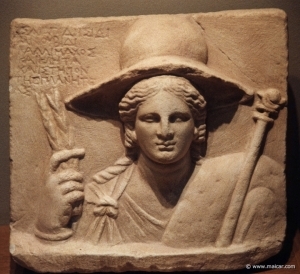 Isis from a temple in Macedonia, 2nd century BCE
Isis from a temple in Macedonia, 2nd century BCEEven during archaic times (as early as 800 BCE), we see traces of devotion, such as inscriptions or votive images, outside of Egypt. By the 4th century BCE, Isis and Her family were adopted into Nubia to the south of Egypt and Greece to the north. Then, from the beginning of Ptolemaic rule in Egypt (305-30 BCE) through the Roman Empire, devotion to Isis spread very quickly.
Due to some ancient documents we still have, we can know that the first temple of Isis was built in Greece, in the Piraeus, Athens’ port city, by the late 4th century BCE. I found an article detailing how that may have come about.
The first thing we hear of it is in a legal document that the folks who had received said document had carved in stone and set up in the Piraeus. They wanted to make sure there would be no mistake that they had proper permission. The people who had it carved were from Cyprus and they had gained permission to set up an Aphrodite sanctuary. The interesting thing for Isiacs is that they had done it on the precedent of Egyptians having built a sanctuary of Isis in the same area. The document is dated to 333/2 BCE. So this means that the formal worship of Isis was established in the Athens area sometime before 333/2 BCE. On the Greek holy island of Delos, sometime about this same period, an altar dedicated to Isis is the oldest of the inscriptions related to the Egyptian Deities.
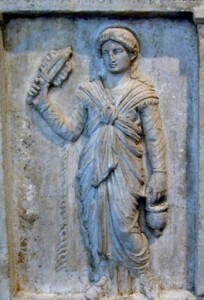 Funerary relief of Sosiba in the dress of Isis, from Attica
Funerary relief of Sosiba in the dress of Isis, from AtticaThe person who had proposed that Athens grant this permission to the Cyrians was a guy named Lycurgus who was in charge of Athenian finances, and so was quite powerful. At least one scholar has suggested that he had something of a personal interest in the previous Isian sanctuary. His grandfather, also named Lycurgus, may have been the one who proposed that the Egyptians be allowed to build their sanctuary. If it was Lycurgus senior who was connected with the Egyptians and their sanctuary, then that would put the establishment of an Isis temple at Athens about the late 5th century BCE.
However, getting foreign sanctuaries built was not an easy thing. And in fact, Lycurgus senior was thoroughly mocked for his promotion of the Egyptian Deities. He was nicknamed “Ibis” in Aristophanes’ comedy, The Birds. An ancient scribe commenting on this nickname opined that he was called that either because he was Egyptian by birth or due to “his Egyptian ways.” A fragment from another comedian pictured Lycurgus wearing a kalasiris, the long, form-fitting sheath dress of an Egyptian woman. Yet another suggests that Lycurgus might be carrying messages home to “his fellow countrymen” in Egypt.
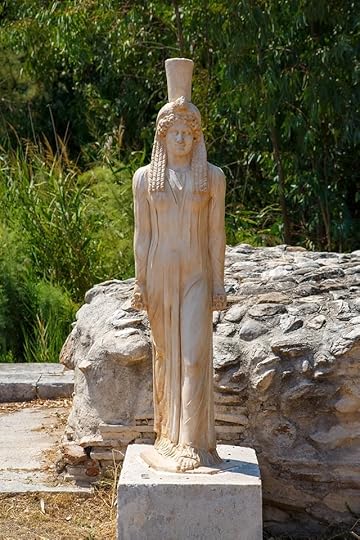 A reproduction of a sacred image of Isis from the private sanctuary near Marathon that is on site today
A reproduction of a sacred image of Isis from the private sanctuary near Marathon that is on site todayMost scholars are pretty sure Lycurgus senior wasn’t Egyptian—and are certain that he was an Athenian citizen—but it seems that he may have indeed been an Egyptophile. What we don’t know for certain is whether Lycurgus the younger was actually the grandson of Lycurgus the Ibis. So there may be no connection at all and the names merely coincidental. The author of the article I’m reading suggests that grants to both to the Isis and Aphrodite devotees may have been more political than religious. Athens had suffered some defeats during this time period. The author suggests that Lycurgus the younger was welcoming sanctuaries from other areas so that he could help build up Athens’ trade and thus its economic power. So it’s always money.
While it may have been money for Lycurgus the financial administrator, it wasn’t just money for other Isis-interested people in the Mediterranean. For instance, we see more Greek parents giving their children names that included Hers at about these same times. Scholars generally agree that when we see an upswing in what are known as theophoric names (“Deity-Bearing” names; for instance, “Isidora” is a theophoric name), we are witnessing an increase in the Deity’s popularity as well. In Greece, we see a few Isis-bearing names in the 3rd century BCE, many in the 2nd century BCE, then an absolute explosion of Isis names from the 1st century BCE through the Roman Imperial period.
Perhaps even more interesting is that people may have taken names that included Hers as a sign of their devotion. This is not so different today. My own theophoric name is a taken name that I legally changed to permanently connect me with Her. And I know I’m not the only one.
 Grave stele of Mousa, daughter of Dionysios, dressed as an Isiac
Grave stele of Mousa, daughter of Dionysios, dressed as an IsiacIsis may have been especially important in Miletus, an ancient Greek city in what is now Turkey. There are five women, known from their funerary reliefs, who all bore the name Isias (or Eisias) and had come to Athens from Miletus. Some scholars have suggested that these women may have been former slaves who were freed in the name of Isis and therefore took the name of their deliverer. Others have suggested that they were initiates of Isis who took Her name—or that they may have been both.
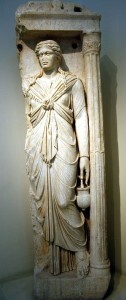 Funerary relief of Alexandra in Isis dress, from Roman-era Athens
Funerary relief of Alexandra in Isis dress, from Roman-era AthensThe five Isis-named women were shown on their grave reliefs in the famous “dress of Isis,” that is, the fringed mantle with Isis knot, and holding the sistrum and situla. But theirs were not the only examples. In fact, we know of 108 such Attic reliefs of women and some men with Isis attributes; the women wear the Isis-knotted dress, while the men hold the sistrum and situla. During the Roman period in Athens, this number makes up one-third of all the known (and published) grave reliefs. If that number reflects true percentages rather than just chance, that’s an awful lot of Isiacs.
In addition to the possibility that these Isis-accoutered people were initiates of Isis, it has also been suggested that they may have either been priest/esses, had a priest/essly function, or may simply have been especially enthusiastic devotees; for example, volunteers who helped maintain the sanctuaries and participated in the rites.
Or they may have been members of religious associations that were connected with the sanctuaries and served both a religious and social function. We know of one such group in particular that was connected to one of the Isis-Sarapis sanctuaries on Delos. It seems likely that enthusiasts would be members, or even founders, of such associations.
People could also stay for a time at the temples. In Apuleius’ tale of initiation into Isis’ Mysteries, prior to deciding to be initiated, his character Lucius simply spends time in Isis’ sanctuary:
I took a room in the temple precincts, and set up house there, and though serving the Goddess as layman only, as yet, I was a constant companion of the priests and a loyal devotee of the Great Deity.
Apuleius, the Golden Ass, Book XI, 19
I wish he had described what specific things he, as a layperson, was allowed to do to serve the Goddess. He does describe, in part, the morning rites to which the public seems to have been welcomed:
I waited for the doors of the shrine to open. The bright white sanctuary curtains were drawn, and we prayed to the august face of the Goddess, as a priest made his ritual rounds of the temple altars, praying and sprinkling water in libation from a chalice filled from a spring within the walls. When the service was finally complete, at the first hour of the day, just as the worshipers with loud cries were greeting the dawn light…
Apuleius, the Golden Ass, Book XI, 20
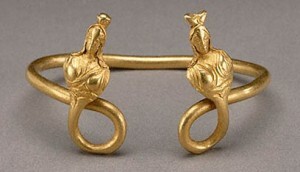 A Hellenistic bracelet with two busts of Isis, made in Egypt
A Hellenistic bracelet with two busts of Isis, made in EgyptFrom the evidence we have from Greek Isis sanctuaries, it seems that the Greeks used priest/essly titles they were familiar with, but with adaptations to fit Isis’ mythos. We have records of a hiereus, a priest, a stolistes, one who adorns the sacred image of Isis, a zakoros, an attendant, a kleidouchos, a key bearer, and a melanophoros, a bearer (or wearer) of the black garments—Isis’ black garments of mourning. We can expect that Isis received offerings of food and drink, as did native Greek Deities.
We have mentions from several Roman writers about devotions to Isis. The poets Propertius and Tibullus complain of the period of sexual abstinence their mistresses undertook for Isis. Ovid writes of the crowds of penitents at the temple of Isis. Tibullus also mentions a ritual called votivas reddere voces in which devotees could join in the singing of the virtues (aretai) of Isis in front of Her temple twice a day. (I wonder if they used any of the aretalogies of Isis we know of.)
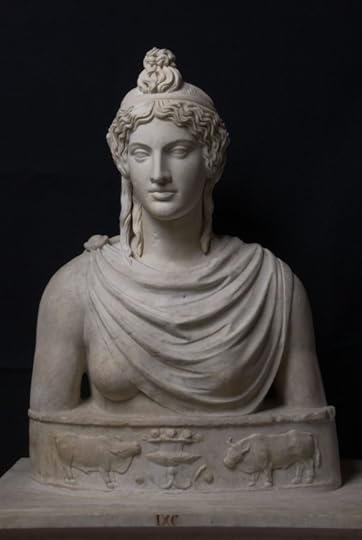 A Renaissance statue of Isis by the sculptor Andrea Bregno, in the style of ancient Rome
A Renaissance statue of Isis by the sculptor Andrea Bregno, in the style of ancient RomeInterestingly, when Isis comes to Rome, Her Roman worshipers seemed to have tried to make Her worship more “Egyptian” than did Her Greek worshipers. For instance, Roman Isis temples celebrated the rising of Sothis. They added back Egyptian symbols, such as the divine animals: crocodile, baboon, and canine. We see the development of lifelong priesthoods, something done in Egypt, but not done in Greece. Some Roman emperors may have especially appreciated the Egyptian relationship between Isis the Throne and the pharaoh. And it is in Italy that we first see priestesses of Isis rather than just priests.
For modern devotees, knowing the ways in which our spiritual ancestors—whether in Her homeland of Egypt or outside of its borders— honored Isis can inspire us in developing our own ways to honor Her. Whether we make offerings of food upon Her altar, pour libations of milk and wine, or sing of Her virtues before our shrines, we honor the Goddess Who fills our hearts and we connect with those who have gone before us.
May 4, 2025
Isis, the Birth Goddess & Lots of Bricks
 Some of Cairo’s red-brick buildings; they’re ubiquitous in Cairo—and every town and city we saw while there.
Some of Cairo’s red-brick buildings; they’re ubiquitous in Cairo—and every town and city we saw while there. Egypt is a land of bricks. From the ancient sun-dried mudbrick temple enclosures to modern Egyptian apartments, everything was and is made of bricks. (And, modernly, supplemented by concrete.)
It’s because there never were many trees and the native ones aren’t very suitable for large building projects. Even anciently, building wood was imported.
So bricks were and are still the answer. the ancient Egyptians encountered bricks on the way into life, during life, and on the way out of life.
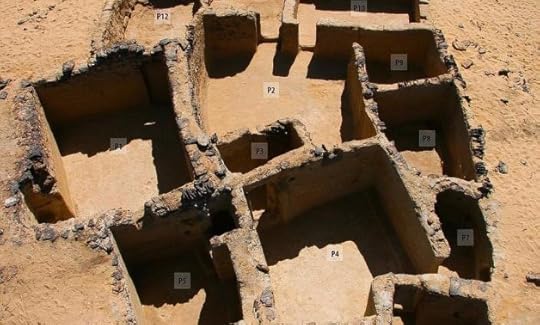 Ancient brick housing
Ancient brick housingThe ones they encountered on the way into and out of life were special. There were magical.
On the way into life, there were four bricks, stacked in pairs, that served to elevate a birthing mother so that when her child emerged beneath her, the baby could easily be caught in the hands of the midwife. (According to midwives even today, a squatting or sitting posture is preferable to the supine position in which most modern Western women give birth, generally resulting in a faster, easier delivery.)
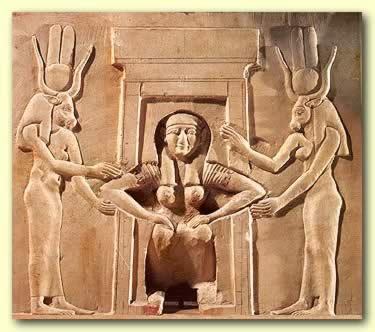 Giving birth while squatting on birthing bricks and supported by Divine midwives
Giving birth while squatting on birthing bricks and supported by Divine midwivesOn the way out of life, there were the four talismanic bricks that were placed in niches in the four sides of a burial chamber. These bricks were decorated with amuletic figures: in the east, the Anubis jackel; in the south, a flame; in the west, the djed pillar of Osiris; and in the north, a mummiform male figure. All of them protected the deceased.
Doubtless, the talismanic bricks that surrounded the body of the deceased in the tomb were meant to assist in rebirth into the next life, just as the birthing bricks assisted in a child’s birth into physical life.
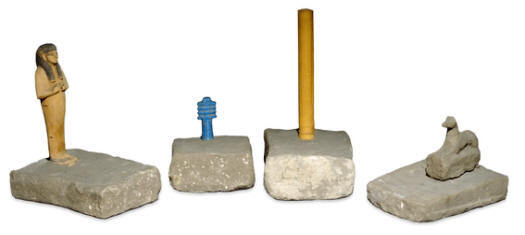 A set of the magical bricks with the amuletic figures atop them
A set of the magical bricks with the amuletic figures atop themThe Goddess most closely associated with the birthing bricks is Meskhenet, Protectress of the Birthing Place. The bricks were called meskhenut (pl.) after Her. Meskhenet is depicted either as a woman-headed birthing brick or as a woman with a distinctive curling headdress that has been identified as a stylized cow’s uterus. She protects mother and child during the dangerous process of birth, She foretells the child’s destiny as the baby is born, and She is among the Deities of rebirth Who witness the judgment of the deceased in the Otherworld.
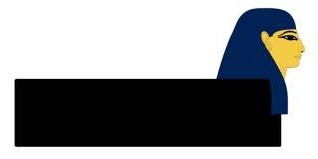 Meskhenet as the personified birthing brick; the bricks were also called “meskhenets”
Meskhenet as the personified birthing brick; the bricks were also called “meskhenets”With Isis’ own connection to both birth and rebirth, you will probably not be surprised to learn that Isis is closely associated with Meskhenet. At Osiris’ temple complex at Abydos, four Meskhenets serve as assistants to Isis in the great work of rebirth done there. At Hathor’s temple complex at Denderah, a combined form of Isis and Meskhenet (Meskhenet Noferet Iset or Meskhenet the Beautiful Isis) is one of the four Birth Goddesses of Denderah. And in the famous story of the birth of three kings found in the Westcar papyrus, both Isis and Meskhenet are among the four Goddesses Who assist in the kings’ births.
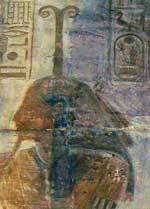 Strangely, here pharaoh Seti I wears Meskhenet’s distinctive headdress of the “horns” of a cow’s uterus
Strangely, here pharaoh Seti I wears Meskhenet’s distinctive headdress of the “horns” of a cow’s uterusBoth tomb bricks and birthing bricks were protective. In an inscription from the temple at Esna, Khnum, the God Who forms the child’s body and ka on His Divine potter’s wheel, places four Meskhenet Goddesses around each of His various forms “to repel the designs of evil by incantations.” As Birth Goddess, Meskhenet is associated with the ka as well. A papyrus in Berlin invokes Her to “make ka for this child, which is in the womb of this woman!”
We have a few surviving spells that were used to charge the birthing bricks. They were used to repel the attacks of enemies to the north and south of Egypt and may indicate that the birthing bricks, like the tomb bricks, were connected with the directions.
And here’s another tidbit showing parallels between the magical tomb bricks and birthing bricks. In an Egypt Exploration Society article by Ann Macy Roth and Catherine H. Roehrig, the authors point out an interesting gender-reversed aspect of these magical bricks.
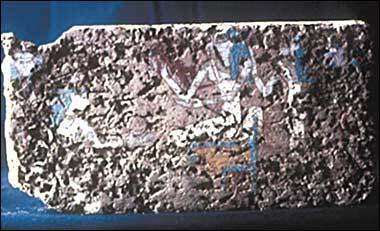 Discovered in 2001, this is the only example of an ancient Egyptian birthing brick that has yet been found
Discovered in 2001, this is the only example of an ancient Egyptian birthing brick that has yet been foundYou may recall that four Sons of Horus are the Gods Who protect the four canopic jars that contain the internal organs of the mummy. These four Gods are, in turn, guarded by four Goddesses. In Tutankhamun’s tomb, the Goddesses are Isis, Nephthys, Selket, and Neith. Roth and Roehrig suggest that we may be able to explain the amuletic figures associated with the tomb bricks in a similar, though opposite, manner. If the four meskhenets are personified as four Goddesses Who protect the birthing place, perhaps the four figures on the tomb bricks—the God Anubis, a mummiform male, a Divine pillar associated with Osiris, and a flame, the hieroglyph for which is rather phallic—may be considered Divine Masculine Powers Who protect the four Meskhenet Goddesses, just as four Goddesses protect the four Sons of Horus.
 A recreation of the scene on the mudbrick birthing brick above
A recreation of the scene on the mudbrick birthing brick aboveIt is worth noting that these magical bricks were made in the same way as were the traditional mudbricks of Egypt. They were fashioned from the fertile Nile clay and sand, mixed with straw, which may be associated with Isis as Lady of the Fertile Earth, then they were dried in the brilliant heat of Isis-Re, the Radiant Sun Goddess. And, of course, as a Divine Mother Herself, Isis is connected with every aspect of human and animal fertility, from conception to birth, as well as the protection of the children as they grow.
As we have a south-to-north flowing river here in Portland, I might see if I can get some Portland “Nile” mud to create four miniature mudbricks. Then I could magically charge them by naming them “Meskhenet Noferet Iset” and placing them in the four quarters of the temple—or even outside, one on each side of the house. They might provide some very fine magical protection.
 Two Meskhenet Goddesses as birthing bricks awaiting the judgment so that They may assist in the deceased woman’s rebirth
Two Meskhenet Goddesses as birthing bricks awaiting the judgment so that They may assist in the deceased woman’s rebirth



